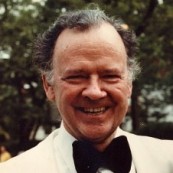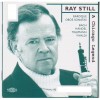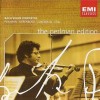| Voice/Instrument: | Oboe |
Biography
Ray Still, the first oboist of the Chicago Symphony for forty years, has enjoyed a long and distinguished career in orchestral, solo, and chamber music. He has played under almost all the major conductors of the last half of the 20th century and has recorded much of the oboe solo repertoire with such artists as the Fine Arts Quartet, Itzhak Perlman, Pinchas Zukerman, Lynn Harrell, and Kathleen Battle. The many students he has taught in graduate and undergraduate programs and international clinics and master classes now staff symphonies and universities around the world. Since retirement, he has toured in Europe, Ireland, Canada and Japan, taught at Northwestern and the University of Maryland, and is now engaged in writing a book on playing the oboe, which will make available to many the ideas he has developed over 60 years. His distinctive tone and musical style have influenced and inspired oboists throughout the world.
Born in Elwood Indiana in 1920, Ray Still moved with his family to a farm in Iowa where he lived till the age of 11 (and where he—only half-jokingly—claims he learned about resonance from calling the hogs). The family moved to Los Angeles, California during the Great Depression and, at the age of fourteen, Still started playing the clarinet seriously. He also ushered without pay at the Los Angeles Philharmonic, simply to hear the music. It was here that he was inspired by the artistry of the great Belgian oboist Henri de Busser, and decided to switch from clarinet to oboe. De Busser who, along with his brother Albert, had studied at the Brussels Conservatory in Belgium also influenced Leon Goosens to become an oboist many years earlier. De Busser had a particular singing way of playing which always stressed the long line—perhaps because he taught as many voice students as oboists in his L.A. studio.
Though Still never studied directly with De Busser, he did study with his disciple and long time associate, Philip Memoli, second oboe to de Busser in the Los Angeles Philharmonic. Memoli later had a long career at the MGM studios in Hollywood recording the sound tracks for many famous movies. He favored the same singing style as that used by DeBusser.
After only one and one half years of oboe study, Still was playing in the Works Progress Administration Orchestra, a creation of President Roosevelt during the Great Depression, and under such conductors as Otto Klemperer and Albert Coates. His early experience also included playing in training orchestras in the Los Angeles area.
His first truly professional job was as second oboist with the Kansas City Philharmonic where at the age of 19 he played second oboe (1939-1941) just before World War II. From 1941-1943, Still studied electrical engineering and was a member of the reserve Signal Corps, US Army, working at night at the Douglas Aircraft factory (a defense plant) until he entered the Army in September 1943. He finished his Army service in June of 1946 and the same summer enrolled at the Juilliard School of Music in New York with the hope of studying with Robert Bloom.
Bloom, solo oboist for Toscanini’s NBC broadcasts, which Still heard in Los Angeles in the early 40s, had become a musical hero. However he did not teach at a school where Still's army service would pay the tuition so he accepted the generosity of Mr. Bloom to teach him free of charge outside of the school. When he moved to New York, Still was supporting a growing family—a wife and two young children—on a stipend of only $80 per month from the US Government. It was necessary to supplement this small income by working as a fry cook, elevator, and wrecking truck operator, making attendance at Juilliard difficult.
Studying here for the equivalent of almost two years, Still played first oboe in the Juilliard orchestra (competing with 27 other oboists) despite the fact that he had really been away from oboe playing for five years. He left Juilliard after auditioning and winning the first oboe position in the Buffalo Philharmonic under William Steinberg, where he stayed from 1947-1949. He then was awarded the first oboe position with the Baltimore Symphony, playing there from 1949-1953, and also teaching at the Peabody Institute. He also played summer seasons under Bernstein in New York and at the Watergate festival in Washington, DC.
When Fritz Reiner was selected to be the new conductor of the Chicago Symphony in the Fall of 1953 he needed an assistant first oboist, and Ray Still auditioned in New York, winning the position. However, the decision to accept anything less than a solo position was a difficult one to make. Yet at Reiner’s repeated urging, and with the safety net of a promised position the following year in New York under Dimitri Metropolis, for whom he had also auditioned, Still decided to take a chance on Chicago. As it turned out Reiner offered Still the first oboe position for the following year, 1954.
Still was with the Chicago Symphony for forty years, during which time he made hundreds of orchestral recordings, many solo appearances and some solo recordings with the orchestra. His favorite solo recordings with the Chicago Symphony are the Mozart Oboe Concerto, Claudio Abbado conducting, (a recording made in approximately forty minutes) and Bach’s Wedding Cantata with the Ravinia Festival orchestra (CSO members) Kathleen Battle and James Levine. His older son, Thomas Still, two years old when Still started at Juilliard, wrote the cadenzas for the Mozart, which many think are the very best ever heard for this concerto.
He has played much chamber music and done extended coaching while attending the Aspen Festival in Colorado, the Marlboro Festival in Vermont, the Festival in Vasa, Finland, Canada, with many master classes in China, England, Ireland,the Hochschule of Vienna, in Rotterdam, in all the Scandinavian countries, and in Mexico, Japan, China, Korea, France etc.
His recorded chamber music includes Oboe Quartets of Mozart, Stamitz, JC Bach and Wanhal with Itzhak Perlman, Pinchas Zukerman, Lynn Harrell for EMI; the Poulenc Trio for Teldec (with John Perry, piano and Milan Turkovic, bassoon); the Schumann Romances and Hindemith Sonata with John Perry (Teldec). His Poulenc and St Saens Sonatas plus two of Thomas Still’s compositions will be released at a future date.
He has also recorded the following: The Strauss Concerto, the Bach Oboe d'Amore Concerto, the Marcello Concerto and Sinfonias from Cantatas 156, 12 and 21 (Virgin Classics) with Richard Stamp and the Academy of London Chamber Orchestra; Bach’s Double Concerto for Oboe and Violin, recorded by Still in Israel with Itzak Perlman and the Israeli Philharmonic Strings; The Bach Wedding Cantata, 202 for RCA with Kathleen Battle, the Mozart Quintet for Piano and winds with James Levine (piano) and Chicago Symphony first chair players.
In May of 2001 Nimbus Records issued a CD called The Chicago Legend . Nimbus considered it a tribute to Still’s entire career. This included the Bach Sonata in G (also known as flute Sonata in B), The Handel Sonatas in G and C, a Vivaldi Sonata in G, and three Telemann Partitas (2, 5, and 6.) The Bach Sonata in G was made in Sweden with his older son, Thomas, playing the harpsichord.
Still organized the Chicago Symphony Winds, basically an octet, which performed all the works of Mozart (for winds alone) in a series of five concerts at the University of Chicago. The group has recorded the Serenade #11 of Mozart, direct to disc on Sheffield Records.
Ray Still taught at the Peabody Institute in Baltimore (1949-53), Roosevelt University in Chicago (1954-1957), and for 43 years as professor at Northwestern University in Evanston, Illinois.
He and his wife of 66 years, Mary Brock of Kansas City MO, have four children, six grandchildren and three great-grandchildren.
A devotee of American Jazz, especially that of the 1920’s through the 1950’s, Still has an extensive record collection. His particular heroes in this field are Louis Armstrong, Lester Young, and Billie Holiday.
He is also a particular lover of vocal music and artists, and lists among his idols Fritz Wunderlich, Elly Ameling, Kiri Te Kanawa, Christa Ludwig, Dietrich Fischer-Dieskau, Jesse Norman, Jorma Hyninen, Bryn Terfel and Tom Krause. His idea of a musician's heaven is to be able to play all the Bach Cantatas and the great Choral works, then the accompaniments to Mozart Concerti and Operas as well as all the Serenades and Divertimenti and Symphonies of Haydn and Mozart.
Besides his teaching at Northwestern University, he is engaged quite often in conducting master classes and coaching wind groups around the world. He is at present working on an extensive instruction book for the oboe which will be published on this website.







